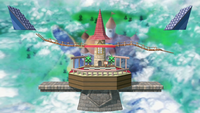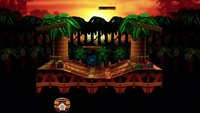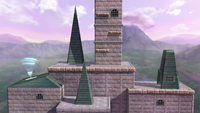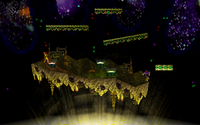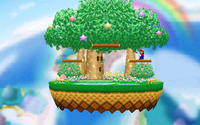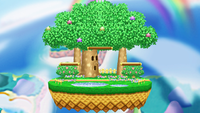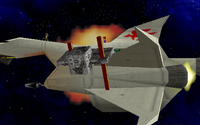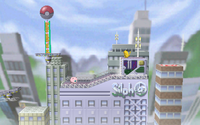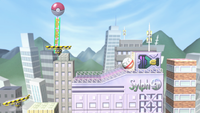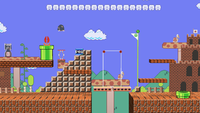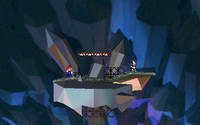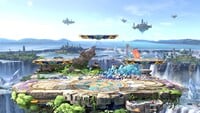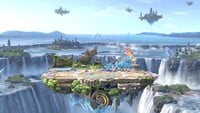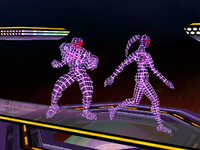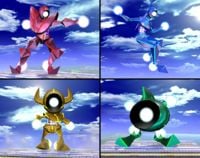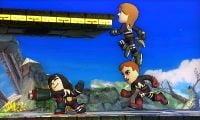List of stages debuting in Super Smash Bros.
This is a list of Super Smash Bros. series stages that debuted in the original Super Smash Bros. game. The page details their role in this series.
See also:
- List of stages debuting in Super Smash Bros. Melee
- List of stages debuting in Super Smash Bros. Brawl
- List of stages debuting in Super Smash Bros. for Nintendo 3DS and Super Smash Bros. for Wii U
- List of stages debuting in Super Smash Bros. Ultimate
Peach's Castle
- Main article: Peach's Castle (Super Smash Bros.)
In the original Super Smash Bros. game and Super Smash Bros. Ultimate, Peach's Castle is available from the start. In Super Smash Bros. for Nintendo 3DS and Super Smash Bros. for Wii U, it was available as a downloadable stage between July 31, 2015 and the discontinuation of the Nintendo eShop service for the Nintendo 3DS and Wii U on March 27, 2023.
Kongo Jungle
- Main article: Kongo Jungle (Super Smash Bros.)
In the original Super Smash Bros. game and Super Smash Bros. Ultimate, Kongo Jungle is available from the start. In Super Smash Bros. Melee and Super Smash Bros. for Wii U, it is available as an unlockable stage.
Hyrule Castle
- Main article: Hyrule Castle § Super Smash Bros. series
In the original Super Smash Bros. game and Super Smash Bros. Ultimate, Hyrule Castle is available from the start. In Super Smash Bros. for Nintendo 3DS and Super Smash Bros. for Wii U, it was available as a downloadable stage between July 31, 2015 and the discontinuation of the Nintendo eShop service for the Nintendo 3DS and Wii U on March 27, 2023.
Planet Zebes
Planet Zebes is a stage that only appears in Super Smash Bros. It is a planet seen in the Metroid series and the main setting of the first and the third game in the series, Metroid and Super Metroid, respectively. The surface is mostly barren and the underground is riddled with large caverns.
The only feature is the acid, that rises about every 30 seconds and damages any players. After a few cycles, it rises so high that only the center platform, which is also the highest, is safe. Samus is always fought here in 1P Mode. The unlocking match for Captain Falcon takes place here, due to the game featuring no F-Zero stages.
The stage itself is not in any of the successors. A similar stage called Brinstar is in the games instead. The stage's music actually returns in Super Smash Bros. Ultimate, however, and can be played on any Metroid-themed stage. Alongside Sector Z, it is one of only two stages from the original Super Smash Bros. game that do not reappear in Super Smash Bros. Ultimate, not counting the Meta Crystal.
Names in other languages
| Language | Name | Meaning | Notes |
|---|---|---|---|
| Japanese | 惑星ゼーベス[?] Wakusei Zēbesu |
Planet Zebes |
Super Happy Tree
- Main article: Super Happy Tree (stage)
In the original Super Smash Bros. game and Super Smash Bros. Ultimate, Super Happy Tree is available from the start. In Super Smash Bros. Melee, it is available as an unlockable stage.
Dream Land
- This section is about the stage originating from Super Smash Bros. For the stage in Super Smash Bros. for Nintendo 3DS, see List of stages debuting in Super Smash Bros. for Nintendo 3DS § Dream Land GB.
Dream Land is a central location in the Kirby series, being Kirby, Meta Knight, and King Dedede's home land. It is also a stage in the game Super Smash Bros. However, it is set in the forest of Dream Land, rather than the village. The stage layout consists of three platforms arranged with two on both sides and one higher platform in the middle. The main feature of the stage is Whispy Woods, who occasionally blows a heavy wind at players which pushes them toward either side of the stage. At certain points, a Bronto Burt or King Dedede can be seen flying by in the background. The "Challenger Approaching!" match to unlock Ness takes place here, due to the game featuring no EarthBound stages.
In Super Smash Bros. Melee, Dream Land reappears as one of the Past Stages.
Dream Land returns in its original form as a DLC stage in Super Smash Bros. for Wii U and Super Smash Bros. for Nintendo 3DS, released June 14, 2015 under the name Dream Land (64). Besides being touched up to higher graphical quality, it was designed to be identical to the original version of the stage. Dream Land also has an Omega version with no platforms, like every other stage, and while Whispy Woods still appears in the background, he does not do anything. While the Bronto Burts and King Dedede still make their background appearances, King Dedede does not appear in this capacity if he is a part of the match.
Dream Land reappears in Super Smash Bros. Ultimate.
Songs
Super Smash Bros. for Nintendo 3DS
| Name | Source | Credits |
|---|---|---|
| Dream Land | Super Smash Bros. (Kirby Super Star) |
Arrangement Supervisor: Hirokazu Ando Composition: HAL Laboratory, Inc. Arrangement: HAL Laboratory, Inc. |
| Ice Cream Island | Kirby's Adventure | Arrangement Supervisor: Yoshihito Yano Composition: HAL Laboratory, Inc. Arrangement: BANDAI NAMCO Studios Inc. |
Super Smash Bros. for Wii U
| Name | Source | Credits |
|---|---|---|
| Dream Land | Super Smash Bros. (Kirby Super Star) |
Arrangement Supervisor: Hirokazu Ando Composition: HAL Laboratory, Inc. Arrangement: HAL Laboratory, Inc. |
| Ice Cream Island | Kirby's Adventure | Arrangement Supervisor: Yoshihito Yano Composition: HAL Laboratory, Inc. Arrangement: BANDAI NAMCO Studios Inc. |
| The Fountain of Dreams | Super Smash Bros. Melee (Kirby Super Star) |
Arrangement Supervisor: Tadashi Ikegami Composition: HAL Laboratory, Inc. Arrangement: HAL Laboratory, Inc. |
| Planet Popstar | Kirby 64: The Crystal Shards | Original |
| Forest Stage | Kirby Air Ride | Original |
| The World to Win | Kirby: Triple Deluxe | Original |
Gallery
Super Smash Bros. for Nintendo 3DS
Names in other languages
| Language | Name | Meaning | Notes |
|---|---|---|---|
| Japanese | プププランド[?] Pupupu Rando |
Pupupu Land | |
| Chinese (simplified) | 梦幻国[?] Mènghuànguó |
Dream Land | Super Smash Bros. |
| 噗噗噗之国[?] Pūpūpū zhī guó |
Pupupu Country | ||
| Chinese (traditional) | 噗噗噗之國[?] Pūpūpū zhī guó |
Pupupu Country | |
| Dutch | Dromenland[?] | Dreamland | Super Smash Bros. for Nintendo 3DS / Wii U |
| Dream Land[?] | - | Supe Smash Bros. Ultimate | |
| French | Pays de Rêves[?] | Land of Dreams | Super Smash Bros. |
| Dream Land[?] | - | ||
| German | Dream Land[?] | - | |
| Italian | Dream Land[?] | - | |
| Korean | 푸푸푸랜드[?] Pupupu Raendeu |
Pupupu Land | |
| Portuguese | Terra dos Sonhos[?] | Land of Dreams | |
| Russian | Страна мечты[?] Strana mechty |
Dream Country | Super Smash Bros. for Nintendo 3DS / Wii U |
| Страна грез[?] Strana grez |
Country of Dreams | Super Smash Bros. Ultimate | |
| Spanish | Dream Land[?] | - |
Sector Z
Sector Z is a stage that only appears in Super Smash Bros. for the Nintendo 64. It is the second largest stage, with the Mushroom Kingdom stage being the largest. This arena takes place on the Great Fox, which is Fox McCloud's ship, in an area of the Lylat system called Sector Z. Occasionally, an Arwing will appear and shoot at the players. It will either shoot a very strong blast across the screen or directly at one of the fighters. The stage did not return in any of the sequels. Instead, they featured two other stages that involve a fight on the Great Fox: Corneria and Venom. However, the stage's music actually returns in Super Smash Bros. Ultimate, and can be played on any Star Fox-themed stage. Alongside Planet Zebes, it is one of only two stages from the original Super Smash Bros. game that do not reappear in Super Smash Bros. Ultimate, not counting the Meta Crystal.
Names in other languages
| Language | Name | Meaning | Notes |
|---|---|---|---|
| Japanese | セクターZ[?] Sekutā Z |
Sector Z (alternatively "Sector Z Abord[sic] a Great Fox" in the original Super Smash Bros.) |
Saffron City
Saffron City is a stage in Super Smash Bros. and returns in Super Smash Bros. Ultimate. The stage is set upon the Silph Co. building and is the home stage of Pikachu and Jigglypuff (with the unlock match for the latter taking place here). The city seems to be modeled after the Pokémon anime, as the games' cities and towns are not as detailed (this includes major cities such as Celadon or Goldenrod). The stage has the most features of any stage in the game. On the right side of the arena, there are floating platforms. On the left side of the arena, there is a door leading down the stairs, but when one tries to go down, a random Pokémon will jump out and attack the player. Here are all of the Pokémon that appear in the building:
| Name | Attack | Description | |
|---|---|---|---|
| Venusaur | Razor Leaf | Venusaur uses Razor Leaf to hit every character in front of it. | |
| Charmander | Flamethrower | Charmander breathes fire at other players. | |
| Electrode | Explosion | Electrode flashes for a while and then uses Explosion to instantly knockout anyone in its blast radius. | |
| Chansey | Softboiled | Chansey uses Softboiled to dispense eggs; they are identical to capsules. | |
| Porygon | Tackle | Porygon suddenly charges out of the building and causes high damage to players hit by it. |
The Silph Co. logo is spelled as "Silf" in the Japanese version. Also, the banner on the left side is slightly altered between both versions. The Japanese banner has an example of Engrish in which it reads "Got a catch 'em all!".
Saffron City is the only stage in Super Smash Bros. that neither returned nor had a similar stage in Super Smash Bros. Melee.
Names in other languages
| Language | Name | Meaning | Notes |
|---|---|---|---|
| Japanese | ヤマブキシティ[?] Yamabuki Shiti |
Yamabuki City. "Yamabuki" (山吹) is the Japanese name of a eastern golden-yellow color flower called Kerria japonica. | |
| Chinese | 金黄市 (Traditional) 金黃市 (Simplified)[?] Jīnhuáng Shì (Mandarin) Gamwong Si (Cantonese)' |
Golden Yellow City | |
| Dutch | Saffron City[?] | Same as English | |
| French | Safrania[?] | From safran ("saffron") | |
| German | Saffronia City[?] | From Safran ("saffron") | |
| Italian | Zafferanopoli[?] | Saffron City | |
| Korean | 노랑 시티[?] Norang Siti |
Yellow City | |
| Russian | Шафран-Сити[?] Shafran-Siti |
Saffron-City | |
| Spanish | Ciudad Azafrán[?] | From azafrán ("saffron") |
Mushroom Kingdom
- Main article: Mushroom Kingdom (Super Smash Bros.)
In the original Super Smash Bros. game, Mushroom Kingdom is available as an unlockable stage. In Super Smash Bros. Ultimate, it is available from the start.
Meta Crystal
- Main article: Meta Crystal
Meta Crystal is a cavern-like stage resembling the Hazy Maze Cave that only appears in Super Smash Bros. It is not unlockable, and it is only used for one battle against Metal Mario in 1P Game.
Battlefield
Battlefield is a recurring stage within the Super Smash Bros. series, appearing in every installment to date. The stage has been designed specially for the Super Smash Bros. series and does not originate from any other Nintendo franchise. Battlefield is a floating stage consisting of a large floor platform and three smaller pass-through platforms hovering above it. The stage does not have any hazards, like Final Destination, which allows players to solely concentrate on the fight. The design has changed in each installment, with early appearances having it in a dark void and later ones in scenic floating ruins.
In Super Smash Bros., Battlefield is the stage where the Fighting Polygons are battled. However, much like Final Destination, the stage cannot be played in VS Mode. Its theme seems to be an arrangement of the music for Mario's castle in Super Mario Land 2: 6 Golden Coins.
Super Smash Bros. Melee is the first game to feature Battlefield as a selectable stage. It can be unlocked by completing All-Star mode on any difficulty. In addition, the Fighting Wire Frames as well as the metal enemies are battled on it.
In Super Smash Bros. Brawl, Battlefield returns as a default stage. The stage now takes a natural green landscape as opposed to the abstract background in the previous games. It also features a day and night system that changes the time of day as the battle goes on. The stage is once again the location where the Fighting Alloy Team is battled.
The Super Smash Bros. for Nintendo 3DS / Wii U variations of this stage take a lot from the design of the Super Smash Bros. Brawl version, as it is in a natural green landscape and features a day and night system that changes as the battle goes on, but the background has been improved slightly. The 3DS version's background consists of several jagged, slanted mountains jutting out from the clouds, while the Wii U version features several floating islands of old, broken architecture covered in small plant life, with a visible moon the center. Additionally, the Wii U version has a larger variant named Big Battlefield designed for 8-player matches, though it can still be used by less players. The platforms are arranged similarly to a pyramid and there are three additional platforms. The Ω form of Battlefield removes the pass-through platforms, although the day and night cycle still occurs. This stage shares its Ω form with Big Battlefield.
The Super Smash Bros. Ultimate variation bears a close resemblance to its predecessor, with similarly styled platforms and main arena. Instead of ruined structures, buildings still intact as well as many waterfalls can be seen in the background. Big Battlefield returns as well. Additionally, every stage in the game includes a Battlefield form, which changes the layout of each stage to resemble Battlefield. In the version 8.1 update released on August 4, 2020, Small Battlefield was added, which features only two platforms, making its layout similar to that of Pokémon Stadium and it is suitable for one-on-one matches. The update also added the ability to play any song in the game on all three variations of Battlefield as well as on Final Destination.[1]
In Super Smash Bros. Melee, the unlock match for Falco takes place here. In Super Smash Bros. for Nintendo 3DS, the unlock match for Duck Hunt takes place here. In Super Smash Bros. Ultimate, the unlock match for Ryu takes place here.
Songs
Super Smash Bros. Brawl
My Music
| Name | Source | Credits | Requirements |
|---|---|---|---|
| Battlefield | Super Smash Bros. Brawl | ||
| Menu (Super Smash Bros. Melee) |
Super Smash Bros. Melee | Arrangement: Motoi Sakuraba | |
| Battlefield Ver. 2 | Super Smash Bros. Brawl | ||
| Battlefield (Melee) | Super Smash Bros. Melee | Original | |
| Multi-Man Melee 1 (Melee) | Super Smash Bros. Melee | Original | Clear 100-Man Brawl in under 4 minutes. |
Not in My Music
| Name | Source | Credits | Plays In |
|---|---|---|---|
| Credits (Super Smash Bros.) | Super Smash Bros. | Arrangement Supervisor: Yusuke Takahama | 10-Man Brawl |
| Cruel Brawl | Super Smash Bros. Brawl | Cruel Brawl | |
| Menu 1 | Super Smash Bros. Brawl | Co-op Event No. 21 ("The True All-Star Battle") |
Super Smash Bros. for Nintendo 3DS
| Name | Source | Credits |
|---|---|---|
| Battlefield | Original | Composition Supervisor: Keiki Kobayashi Composition: BANDAI NAMCO Studios Inc. Arrangement: BANDAI NAMCO Studios Inc. |
| Menu (Melee) | Super Smash Bros. Melee | Arrangement: Motoi Sakuraba Composition: HAL Laboratory, Inc. |
Super Smash Bros. for Wii U
| Name | Source | Credits | Requirements |
|---|---|---|---|
| Battlefield | Original | Composition Supervisor: Keiki Kobayashi Composition: BANDAI NAMCO Studios Inc. Arrangement: BANDAI NAMCO Studios Inc. |
Available by default |
| Multi-Man Smash | Original | Arrangement Supervisor: Yoshihito Yano Composition: BANDAI NAMCO Studios Inc. Arrangement: BANDAI NAMCO Studios Inc. |
Available by default |
| Trophy Rush | Original | Arrangement Supervisor: Katsuro Tajima Composition: BANDAI NAMCO Studios Inc. Arrangement: BANDAI NAMCO Studios Inc. |
Available by default |
| Credits (Super Smash Bros.): Ver. 2 | Super Smash Bros. | Arrangement Supervisor: Ryo Nagamatsu Composition: HAL Laboratory, Inc. Arrangement: Nintendo |
Collect CD |
| Menu (Melee) | Super Smash Bros. Melee | Arrangement: Motoi Sakuraba Composition: HAL Laboratory, Inc. |
Available by default |
| Boss Battle (Melee) | Super Smash Bros. Melee | Arrangement Supervisor: Shogo Sakai Composition: HAL Laboratory, Inc. Arrangement: HAL Laboratory, Inc. |
Available by default |
| Multi-Man Melee 2 | Super Smash Bros. Melee | Original | Clear Solo 100-Man Smash within 3 minutes while playing as Mii Swordfighter |
| Cruel Smash (Brawl) | Super Smash Bros. Brawl | Original | Collect CD |
| Battlefield (Brawl) | Super Smash Bros. Brawl | Original | Available by default |
| Battlefield Ver. 2 (Brawl) | Super Smash Bros. Brawl | Original | Collect CD |
| Boss Battle Song 1 (Brawl) | Super Smash Bros. Brawl | Original | Available by default |
| Menu | Original | Arrangement Supervisor: Junichi Nakatsuru Composition: BANDAI NAMCO Studios Inc. Arrangement: BANDAI NAMCO Studios Inc. |
Available by default |
Multi-Man mode enemies
Fighting Polygons
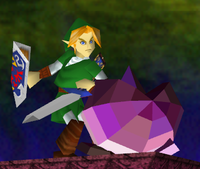
- SmashWiki article: Fighting Polygon Team
The Fighting Polygons (also called the Fighting Polygon Team) are a group of weak enemies found in Super Smash Bros. They possess very little attack and defense prowess, but their numbers can pose a threat (the player fights 30 of them in the penultimate stage of the 1P Game).
Their bodies are all the characters' basic polygon structure (hence their name), all colored purple. Their designs appear edited from the original mode. They do not have the voices of the characters they are modeled after, making them completely silent. For example, Kirby's version appears as a cake, and Yoshi's version has three teeth. Mario, Luigi and Ness' versions look very similar to each other, only being told apart by their moving pattern (Ness's version makes the same glittering noise of the real Ness when jumping) and that the Ness one's nose is lower than Mario one's nose.
Names in other languages
| Language | Name | Meaning | Notes |
|---|---|---|---|
| Japanese | 謎のザコ敵軍団[?] Nazo no zakoteki gundan |
Mysterious Small Fry Enemy Corps |
Fighting Wire Frames
- SmashWiki article: Fighting Wire Frames
The Fighting Wire Frames appear in Super Smash Bros. Melee, replacing the Fighting Polygons. Wire Frames have the same attack pattern as Zelda and Captain Falcon (minus the special moves), and are constructed of purple wires with internal organs visible. Fighting Wire Frames can be fought in a Stadium Mode called Multi-Man Melee. Six different scenarios can be chosen here, 10-Man Melee, 100-Man Melee, 3-Minute Melee, 15-Minute Melee, Endless Melee, or the expert leveled Cruel Melee.
Names in other languages
| Language | Name | Meaning | Notes |
|---|---|---|---|
| Japanese | 謎のザコ敵軍団[?] Nazo no zakoteki gundan |
Mysterious Small Fry Enemy Corps | |
| Italian | Sagoma[?] | Shape | |
| Spanish | Modelos 3D de Lucha[?] | 3D Fighting Models |
Fighting Alloy Team
- SmashWiki article: Fighting Alloy Team
The Fighting Alloy Team appears in Super Smash Bros. Brawl, replacing the Fighting Wire Frames. The four kinds of Alloys are the Red Alloy, Blue Alloy, Yellow Alloy, and Green Alloy. Each Alloy resembles a playable character's moveset:
- Red Alloy: Captain Falcon
- Blue Alloy: Zelda
- Yellow Alloy: Mario
- Green Alloy: Kirby
The Fighting Alloy Team makes an appearance in Super Smash Bros. Ultimate as an Advanced-class support spirit that occupies one support slot. Fighters that use this spirit will start a battle with a Ray Gun. The spirit battle takes place on the Battlefield form of Final Destination, where the player faces four Captain Falcons, four Zeldas, four Marios and four Kirbys.
Names in other languages
| Language | Name | Meaning | Notes |
|---|---|---|---|
| Japanese | 謎のザコ敵軍団[?] Nazo no zakoteki gundan |
Mysterious Small Fry Enemy Corps | |
| Chinese | 謎之雑兵軍團[?] Mí zhī zábīng jūntuán |
Mysterious Small Fry Enemy Corps | |
| German | Metalloid[?] | from metall ("metal") and "android", also a play on "metalloid" | |
| Italian | Zaamar[?] | Portmanteau of "zamak" and armata ("army") | |
| Spanish | Aleados[?] | From aleación ("alloy") and aliados ("allies") |
Fighting Mii Team
- Main article: Mii § Super Smash Bros. series
- SmashWiki article: Fighting Mii Team
The Fighting Mii Team appears in Super Smash Bros. for Nintendo 3DS / Wii U and Super Smash Bros. Ultimate, replacing the Fighting Alloy Team. Unlike the previous teams whose characters have a set appearance, the Fighting Mii Team uses Miis that are saved in the player's system; the Miis' heads are loaded onto a pre-set body and are randomly given either the Mii Brawler, Mii Swordfighter, or Mii Gunner moveset, albeit without special moves, grabs, and the abilities to pick up items and grab ledges.
Events
- No 1: Trouble King (Melee)
- No 36: Space Travelers (second half) (Melee)
- No 37: Legendary Pokémon (Melee)
- No 44: Mewtwo Strikes! (Melee)
- No 20: All-Star Battle x 1 (Brawl)
- Co-op No 21: The True All-Star Battle (Brawl)
Gallery
Names in other languages
Battlefield
| Language | Name | Meaning | Notes |
|---|---|---|---|
| Japanese | デュエルゾーン (Super Smash Bros.) Dyueru Zōn 戦場 Senjō[?] |
Duel Zone Battlefield |
|
| Chinese | 戰場 (Traditional) 战场 (Simplified)[?] Zhànchǎng |
Battlefield | |
| Dutch | Slagveld[?] | Battlefield | |
| French | Champ de bataille[?] | Battlefield | |
| German | Schlachtfeld[?] | Battlefield | |
| Italian | Le rovine[?] | The ruins | |
| Korean | 전장[?] Jeonjang |
Battlefield | |
| Portuguese | Campo de Batalha[?] | Battlefield | |
| Russian | Поле боя[?] Pole boya |
Battlefield | |
| Spanish | Campo de batalla[?] | Battlefield |
Big Battlefield
| Language | Name | Meaning | Notes |
|---|---|---|---|
| Japanese | 大戦場[?] Daisenjō |
Big Battlefield | |
| Chinese | 大戰場 (Traditional) 大战场 (Simplified)[?] Dà zhànchǎng |
Big Battlefield | |
| Dutch | Groot Slagveld[?] | Big Battlefield | |
| German | Großes Schlachtfeld[?] | Big Battlefield | |
| Italian | Le rovine XL[?] | The XL ruins | |
| Korean | 대전장[?] Dae Jeonjang |
Big Battlefield | |
| Portuguese | Campo de Batalha XL[?] | Battlefield XL | |
| Russian | Большое поле боя[?] Bol'shoye pole boya |
Big Battlefield | |
| Spanish | Gran campo de batalla[?] | Big Battlefield |
Small Battlefield
| Language | Name | Meaning | Notes |
|---|---|---|---|
| Japanese | 小戦場[?] Kosenjō |
Small Battlefield | |
| Chinese | 小戰場 (Traditional) 小战场 (Simplified)[?] Xiǎo zhànchǎng |
Small Battlefield | |
| Dutch | Klein Slagveld[?] | Small Battlefield | |
| French | Petit Champ de Bataille[?] | Small Battlefield | |
| German | Kleines Schlachtfeld[?] | Small Battlefield | |
| Italian | Le rovine XS[?] | The Ruins XS | |
| Korean | 소전장[?] So Jeonjang |
Small Battlefield | |
| Russian | Маленькое поле боя[?] Malen'koye pole boya |
Small Battlefield | |
| Spanish | Pequeño campo de batalla[?] | Small Battlefield |
Final Destination
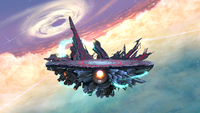
Final Destination is a stage that appears in every Super Smash Bros. game to date. It consists only of a large, featureless platform with no movement, hazards, or other disruptive elements. Final Destination floats around space, showing various backgrounds. The places that the platform travels through and the appearance of the platform itself differ between games.
In Super Smash Bros., Final Destination only appears as the battlefield on which the player fights Master Hand in Classic mode.
Final Destination reappears in Super Smash Bros. Melee as an unlockable stage, unlocked by clearing the Event Match "The Showdown", and is still where the battle against Master Hand is held in Classic mode. The player may also battle Crazy Hand, if the right conditions are met. Final Destination is also where the player battles Giant Bowser in Adventure mode. If the right conditions are met, the player is also be able to battle Giga Bowser afterwards.
In Super Smash Bros. Brawl, the stage is available from the start. Like in the past titles, it is a simple platform. In The Subspace Emissary, a Final Destination-like stage is the location of the final battle with Tabuu.
Final Destination returns in Super Smash Bros. for Nintendo 3DS/Wii U, with a different look. Like Brawl, it features a background that takes place in space. It should also be noted that every stage has an alternate Final Destination incarnation. Also, in a new mode of online play, For Glory mode, these versions of the stages are the only stages available. Stages in their Final Destination form are stylized as Stage Name (Ω Form).
Final Destination returns again in Super Smash Bros. Ultimate. Its main platform now has the same length as Battlefield; additionally, all Ω-form stages are standardized to having the stage set on a large platform floating over an abyss like the original Final Destination, as opposed to a large pillar with walls leading down to the bottom as is the case with several Ω-form stages in the previous game. As of the version 8.1 update released on August 4, 2020, any song in the game can be played on this stage as well as on all three variations of Battlefield.[2]
In both Melee and Brawl, the unlock match for Ganondorf takes place here; in the former, this is also true of the unlock match for Mewtwo.
Songs
Super Smash Bros. Brawl
My Music
| Name | Source | Credits | Requirements |
|---|---|---|---|
| Final Destination | Super Smash Bros. Brawl | ||
| Credits (Super Smash Bros.) | Super Smash Bros. | Arrangement Supervisor: Yusuke Takahama | Clear Classic mode on Hard difficulty. |
| Opening (Super Smash Bros. Melee) | Super Smash Bros. Melee | Arrangement Supervisor: Kentaro Ishizaka | Grab CD |
| Final Destination (Melee) | Super Smash Bros. Melee | Original | Grab CD |
| Giga Bowser (Melee) | Super Smash Bros. Melee | Original | Grab CD |
Not in My Music
| Name | Source | Credits | Plays In |
|---|---|---|---|
| Hidden Mountain & Forest | The Legend of Zelda: A Link to the Past | Original | Fight with Ganondorf |
Super Smash Bros. for Nintendo 3DS
| Name | Source | Credits |
|---|---|---|
| Final Destination | Original | Arrangement Supervisor: Torine Composition: BANDAI NAMCO Studios Inc. Arrangement: BANDAI NAMCO Studios Inc. |
| Menu (Melee): Ver. 2 | Super Smash Bros. Melee | Arrangement Supervisor: Nobuko Toda Composition: HAL Laboratory, Inc. Arrangement: FILM SCORE LLC |
Super Smash Bros. for Wii U
| Name | Source | Credits | Requirements |
|---|---|---|---|
| Final Destination | Original | Arrangement Supervisor: Torine Composition: BANDAI NAMCO Studios Inc. Arrangement: BANDAI NAMCO Studios Inc. | |
| Final Destination Ver. 2 | Original | Arrangement Supervisor: Junichi Nakatsuru Composition: BANDAI NAMCO Studios Inc. Arrangement: BANDAI NAMCO Studios Inc. | |
| Master Hand | Original | Arrangement Supervisor: LindaAI-CUE Composition: BANDAI NAMCO Studios Inc. Arrangement: BANDAI NAMCO Studios Inc. | |
| Menu (Melee): Ver. 2 | Super Smash Bros. Melee | Arrangement Supervisor: Nobuko Toda Composition: HAL Laboratory, Inc. Arrangement: FILM SCORE LLC | |
| Credits (Super Smash Bros.) | Super Smash Bros. Brawl (Super Smash Bros.) |
Arrangement Supervisor: Yusuke Takahama | |
| Metal Battle (Melee) | Super Smash Bros. Melee | Original | Collect CD |
| Final Destination (Melee) | Super Smash Bros. Melee | ||
| Giga Bowser (Melee) | Super Smash Bros. Melee | ||
| Final Destination (Brawl) | Super Smash Bros. Brawl | ||
| Boss Battle Song 2 (Brawl) | Super Smash Bros. Brawl | ||
| Master Core | Original | Arrangement Supervisor: LindaAI-CUE Composition: BANDAI NAMCO Studios Inc. Arrangement: BANDAI NAMCO Studios Inc. |
Clear Classic at Intensity 5.5 or higher |
| Master Fortress: First Wave | Original | Arrangement Supervisor: LindaAI-CUE Composition: BANDAI NAMCO Studios Inc. Arrangement: BANDAI NAMCO Studios Inc. |
Clear Solo Classic at intensity 8.0 with 2 characters |
| Master Fortress: Second Wave | Original | Arrangement Supervisor: LindaAI-CUE Composition: BANDAI NAMCO Studios Inc. Arrangement: BANDAI NAMCO Studios Inc. |
Clear Solo Classic at intensity 8.0 with 3 characters |
Gallery
Luigi battling Master Hand on the original Final Destination
Final Destination's appearance in Super Smash Bros. Melee
Final Destination's appearance in Super Smash Bros. Brawl
Final Destination in Super Smash Bros. for Nintendo 3DS
Final Destination in Super Smash Bros. for Wii U
Final Destination in Super Smash Bros. Ultimate with the dark background
Names in other languages
| Language | Name | Meaning | Notes |
|---|---|---|---|
| Japanese | 終点[?] Shūten |
Endpoint | |
| Chinese | 終點 (Traditional) 终点 (Simplified)[?] Zhōngdiǎn |
Endpoint | |
| Dutch | Eindstation[?] | Terminal Station (lit.: End Station) | |
| French | Destination Finale[?] | Final Destination | |
| German | Letzte Station[?] | Last Station | |
| Italian | Destinazione finale[?] | Final Destination | |
| Korean | 종점[?] Jongjeom |
Terminus | |
| Portuguese | Destino Final[?] | Final Destination | |
| Russian | Последняя арена[?] Poslednyaya arena |
Last Arena | |
| Spanish | Destino final[?] | Final Destination |
References
- ^ @NintendoAmerica (August 4, 2020). "A Super #SmashBrosUltimate update, Ver. 8.1.0, is available now! This update includes a new stage, Small Battlefield. Plus, you’ll now be able to select from all music tracks when playing on Final Destination and Battlefield stages!" Twitter. Retrieved August 4, 2020.
- ^ @NintendoAmerica (August 4, 2020). "A Super #SmashBrosUltimate update, Ver. 8.1.0, is available now! This update includes a new stage, Small Battlefield. Plus, you’ll now be able to select from all music tracks when playing on Final Destination and Battlefield stages!" Twitter. Retrieved August 4, 2020.
| Super Smash Bros. | ||||
|---|---|---|---|---|
| Playable characters | Donkey Kong • Fox • Kirby • Link • Luigi • Mario • Samus • Yoshi • Others | |||
| Non-playable characters | Bob-omb • Whispy Woods | |||
| Bosses | Giant Donkey Kong • Metal Mario | |||
| Stages | Peach's Castle • Yoshi's Island • Congo Jungle • Hyrule Castle • Meta Crystal • Mushroom Kingdom • Others | |||
| Items | Barrel • Bob-omb • Crate • Egg • Fire Flower • Green Shell • Hammer • Red Shell • Star • Star Rod • Target | |||
| Moves | Miscellaneous | Jump • Taunt | ||
| Special | Standard | Up | Down | |
| Mario | Fireball | Super Jump Punch | Mario Tornado | |
| Luigi | Green Fireball | Luigi Cyclone | ||
| Donkey Kong | Giant Punch | Spinning Kong | Hand Slap | |
| Yoshi | Egg Lay | Egg Throw | Yoshi Bomb | |
| Other | Ask Dan • Ask Uncle Tusk • Gallery • Glitches • Pre-release and unused content • Quotes • Smash Card • Super Smash Bros. Poll • Super Smash Bros. (Shockwave game) • Staff | |||
